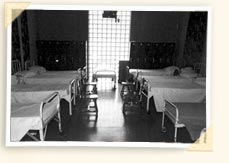 If I had been psychiatrist-in-chief
from 1965 to 1994… If I had been psychiatrist-in-chief
from 1965 to 1994…
I would still probably be a man and would be known as the executive
director of the newly-renamed Douglas Hospital. What an honor
to preside over the ribbon-cutting ceremony at the official
opening of our Services for Retarded Children. In attendance:
Dr. Dominique Bédard, director of the Psychiatric Services
Division of the Ministry of Health; Dr. Denis Lazure, associate
director; the Right Rev. R.K. Maguire, Bishop of Montreal (Anglican),
and the Most Rev. LT. Whalen, Auxiliary Bishop of Montreal
(R.C.).
With the increasing popularity of our after-care services,
which doubled in size in 4 years and were treating 1,400 patients
by 1965, we would ask ourselves whether it would not make sense
to develop an outpatient program that would treat patients
before they would be admitted. It would sound radical, but
we would dare to imagine that our treatments were good enough
to enable us to totally bypass hospitalization. Not to be deflated
by the “I told you so” we would hear the first
year, when only 39 patients were referred to our Screening
Clinic, our perseverance would pay off, as we would become
increasingly convinced that outpatient treatment was where
modern psychiatric treatment was heading.
Alfred Perry would
not have recognized the hospital he inaugurated, with its new
Behavior Therapy Unit using state-of-the-art techniques such
as relaxation, desensitization, and assertive and aversion
therapy; and a recently-opened Data Processing Center that
promised to soon buy a computer for the hospital. In 1967,
we would become the first psychiatric hospital to be accredited
in Canada, but it would seem that the more we accomplished,
the more was expected of us.
Our Planning Council’s 1970
hospital objectives were particularly daunting; reduce in-patients
beds, improve staff-patient ratios; continue increased emphasis
on out-patient treatment; eliminate dependence on patients
for essential hospital work and their replacement by staff
(there goes the budget); augment medical staff; improve the
Perry, Porteous and Northwest pavilions; improve rehabilitation
services and develop comprehensive psychiatric services for
the surrounding population.
Having decreased our inpatient
population by almost 40% in 5 years, going from 1,892 to 1,200
beds, we could not fathom how we could be expected to close
more beds. I would be quite stressed by the objectives and
not quite know where to begin. Despite my trepidations, we
would manage to launch our first community mental health clinic
in LaSalle in 1972. As services were now being offered according
to sectors, and not on the basis of language, we would be treating
increasing numbers of French-speaking patients and would have
to reorganize our services accordingly. In addition to the
numerous challenges we faced within the hospital, the Ministry
would introduce laws that would really complicate medical leadership.
With the introduction of Bill 65 in 1971, the position of medical
superintendent would be abolished and we would have to appoint
a director of professional services. In addition, admission
of involuntary patients would become very complicated. Whereas
it had been previously up to the medical superintendent and
the referring physician to decide who could be hospitalized
against their will, we would now be saddled with having to
perform 2 psychiatric examinations, fill out legal documents,
and obtain approval from the courts.
By 1972, with the passing
of the Mental Patients Protection Act, we would be transformed
from an institution where the majority of patients were involuntary
to a hospital where only 10-15% of admissions were being held
against their will. Perhaps the extra paperwork made people
think twice before committing patients to hospital.
In 1977,
as I would be getting ready for the Auxiliary Fundraising Ball,
being held at the posh Windsor Hotel, I would reflect on the
theme "Let's Build Bridges, Not Walls" and sense
that were progressing, despite the unfavorable accreditation
report of 1973. By 1979, our new research center would open
and one year later our brain bank.
Finally, in 1981, we would
become a World Health Organization Collaborating Centre for
Research and Training in Mental Health and the stage would
be set for the Douglas to become an internationally-renowned
institution in the mental health field. Over the next 10 years,
as we focussed on raising funds in order to carry out our ambitious
projects in research, teaching and care, we would be indebted
to our Foundation, for their unrelenting efforts would help
us make our dreams come true.
The Douglas had become a big
institution with a tripartite mission. In 1994, when at a crossroads
with respect to leadership, we would recruit our first non-medical
director general who would decide to create a department of
psychiatry. At last, the Douglas Hospital would have its first
real psychiatrist-in-chief.
«« Back
|